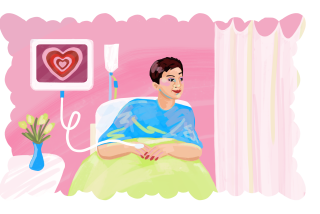Drama at the Bedside
The woman lay in a deep coma in the intensive care unit of Daniel Freeman Memorial Hospital, monitored by electronics. A respirator kept her alive.
She was in her late 40s and, but for her coloring and the almost imperceptible rise and fall of her chest, she might have been dead.
Dr. Bruce Dobkin reached out and gently touched her face.
“Eleanor?” he said. “Can you hear me?”
Then, softly, reflectively, “What goes on in there, Eleanor?”
He turned away from the bed. “She has multiple sclerosis and OD’d on something. We don’t know what yet and we don’t know if it was accidental or deliberate.
“But she’ll wake up. Tomorrow, maybe. Or the next day.”
Dobkin left her bedside and moved slowly through the rest of the ICU, stopping to talk to a doctor named Fred coming the other way.
“How’s Melba doing?” Fred asked.
Melba was another patient, an 84-year-old woman who fell at home and emerged from the accident confused.
“Better,” Dobkin said. “She understood my sense of humor this morning. I consider that a breakthrough.”
“A breakthrough?” Fred said. “It’s a miracle.”
They laughed and continued on their rounds.
I walked with Dobkin down the polished corridor of the neurology wing. He was silent for several moments and then said, “Emotional burdens sometimes become very heavy in medicine. It’s more than just fixing and forgetting.
“When a patient enters your office, they enter your life. The burden comes from a willingness to be close. It makes you a better doctor.”
He turned into a room with another patient.
Dobkin, a neurologist, is director at the Daniel Freeman Memorial Hospital Rehabilitation Center and head of the Stroke Center at UCLA.
And he’s written a book.
The book is called “Brain Matters.” It’s about people coping, about a boy coming to manhood and about the cluster of cranial cells that has brought us out of the trees and into the nuclear age. That dubious progression could send us back into the trees, but that isn’t the point.
Reason may even lie ahead.
I liked “Brain Matters” because it takes us into a real world of hope and pain, cure and death, where judgments are pronounced with anguish, not dispassion, and where one can share the humanity of a young neurologist whose job often entails the making of those judgments.
I liked it so much, in fact, that I agreed to talk to its author, which is the journalistic equivalent of feeding one stray cat in a community that has thousands. I may be doomed to nourishing hordes of other authors hustling their books, but I’ll deal with that when the time comes.
Dobkin is a slightly built man of 40 with a self-effacing manner and a synaptic sense of humor who claims that he learned about medicine from watching the old Ben Casey shows on television. The book, he says, was another fluke.
“I wrote a medical article for Life magazine. An editor telephoned and said he was putting together a bio to accompany the article and was worried that there wasn’t much to say about me.
“He asked if he could say that I was working on a book and I reluctantly replied that I guessed it was OK. ‘Fine,’ he said, ‘what’s the title?’ ”
Dobkin thought about it for 24 hours and “Brain Matters” was born.
Much of what I found valuable in the book was the intensity of Dobkin’s caring, which was interwoven through case histories as full and tense as the best fiction. Much of the caring involved his own father, Duke.
For as the neurologist develops page by page through “Brain Matters,” we bear witness to the slow, painful death of the neurologist’s father and a reversal of their roles that gives “Brain Matters” a special substance.
We see the son become the father figure in a cycle of physiology as relentless as time.
I asked Dobkin why, with his obvious sensitivities, he chose neurology, where so much can go wrong and with such devastation.
We were standing by the nurse’s station in the muted quiet of Daniel Freeman.
“Neurology,” he said, “is the cutting edge of a new frontier, a way to the core of intelligence and philosophy, where medicine can learn even through its errors.
“There is a sadness and a perversity to that, I suppose, but what we learn from error will help others. We are on the brink of breakthrough. . . . “
He remained silent for a moment, thinking. Then: “For me just to be able to stand here and talk and gesture requires all kinds of automatic things going on in the basal ganglia. The whole brain is constantly being driven, interconnected with speech and memory and language. Every cortical cell has 5,000 or 10,000 connections to other nerve cells, talking, energizing, inhibiting. . . . “
His voice trailed off. Then he said, “This is exciting stuff.”
Indeed.
More to Read
Sign up for Essential California
The most important California stories and recommendations in your inbox every morning.
You may occasionally receive promotional content from the Los Angeles Times.










